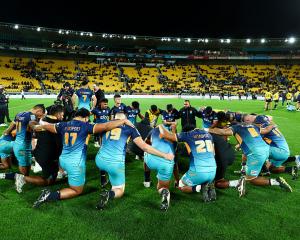ODT Online rugby writer Jeff Cheshire picks out his five key points from Otago's loss in the Ranfurly Shield challenge against Counties Manukau at the weekend.
They played the whole game
To start with the biggest positive, even though Otago lost it was not for a lack of effort and they refused to go away. With the score at 26-13 it would have been easy to throw the towel in and let Counties-Manukau run away with the game. The same could be said with the score at 29-20 and only minutes to play. But they did not. Both times they showed great endeavour and desperation, scoring tries and giving themselves a sniff.
There was plenty of intent evident in Otago's game right from the start. The forwards were hitting the rucks hard, the backs chased well and the loosies were energetic and quick around the park. Defensively they found themselves under a lot of pressure at times and while they let their opponents through, they made them work and defended their line well.
Questionable lineout call
One of the key moments came when Counties-Manukau scored their second try, one which came after a botched Otago lineout. It would be easy to lay blame on Liam Coltman for missing his target with the throw. No doubt he needs to take some of the criticism, but not all of it. It was a strange lineout call.
With the team on their own line and under pressure, the priority should have been on winning the ball, rather than getting ball for an easier clearance. By calling the ball to the back, it was creating a harder throw which always had more chance of going wrong. Coltman had been throwing alright up until that point, but given his known inconsistencies, it would perhaps have been better to give him an easier throw in this crucial moment.
Additionally, by throwing to the back there was no defensive cover for if the throw did go long. With the first-receiver in the pocket for the clearance kick and the first man in the line a bit wider, there was a huge gap behind the jumper that was always going to be hard to cover. By throwing even one position further forward would have meant that there would have been an Otago player there to compete for the loose ball, or to make a tackle. It is good to back yourself and be positive, but in this situation it may have been a better option to call to the front or middle.
Poor basic skills
There were too many mistakes from both teams, that was obvious. Dropped balls, inaccurate lineouts, missed tackles and poor passes were all on show. Both teams were as guilty as each other and squandered chances, while also putting themselves under unnecessary pressure. This is one of the key differences between the ITM Cup and Super Rugby. Every level you go up, you have to be that much more accurate in what you do, as less chances are going to come along. The best teams in any competition are always likely to be the ones which make the fewest mistakes. This is something to work on for Otago, as with a few less dropped balls, they could have very well won this game.
Forwards slightly too slow in support
Just as the accuracy of the game increases with each level you go up, so does the game's speed.
This was evident in this game too, as there were times when the Otago forwards were just a second too slow supporting their man on the ground. It was often only a second, but this was crucial as it was allowing Counties-Manukau to turnover Otago ball and stop the flow of attack. In club rugby, you would get away with this. Even against a Championship team you probably would. But against a Premiership team like Counties-Manukau, you have to be that split second quicker the whole game.
For the most part they were not too bad and the likes of Lee Allan and James Lentjes tore around the field. It only takes a few instances of being too slow though and Counties-Manukau exploited these well.
Good array of set-moves
Another week saw a whole new group of set-moves being used. It is good to see Otago playing in this way and showing some creativity in their thinking and preparation. There are few sights better on a rugby field than to see a set-move work and result in the defence being left in a position where they are powerless to stop what is happening in front of them. Indeed, scoring tries off the first phase is more or less non-existent in this day and age. Defences are generally well organized.
Attacking teams prefer to set a ruck and try to manipulate the defence through pressure, drawing defenders into more narrow channels to create space out wide. By using a well thought-out set-move, timed well and with good angles, it can be nearly impossible to defend and looks so nice when it comes off.











